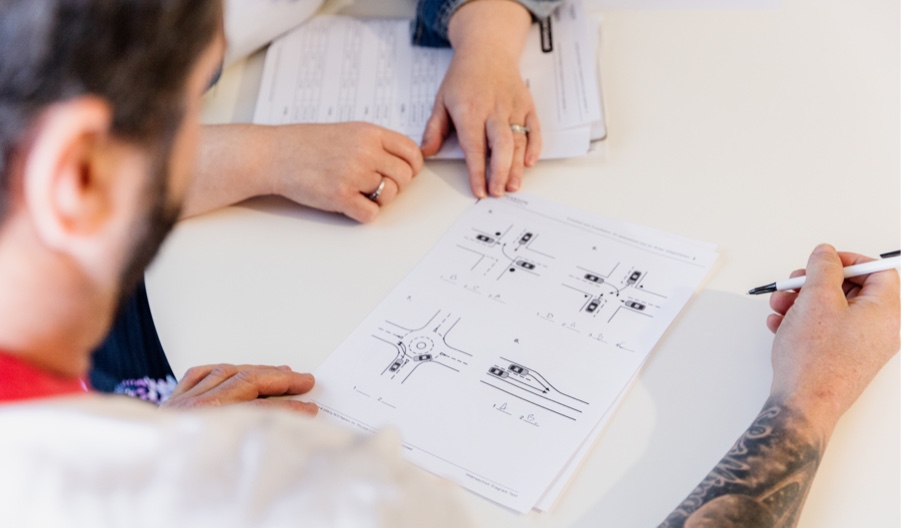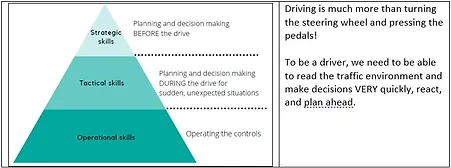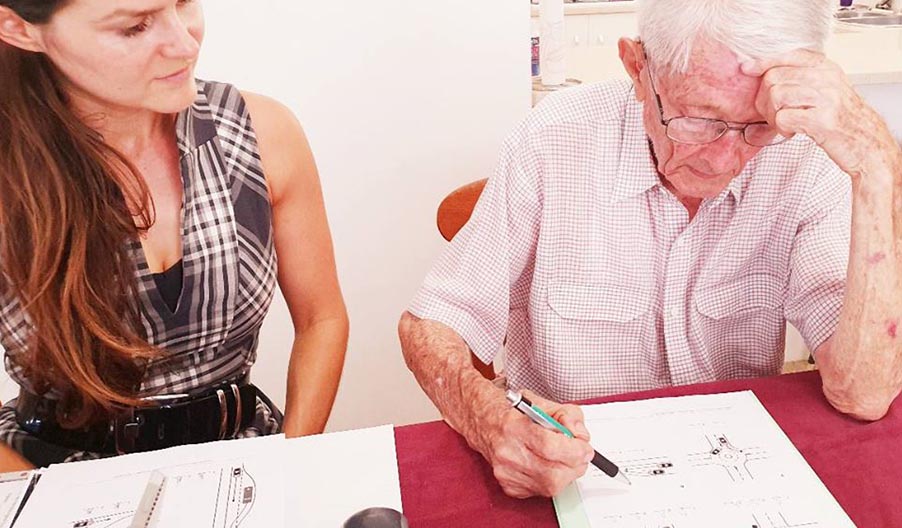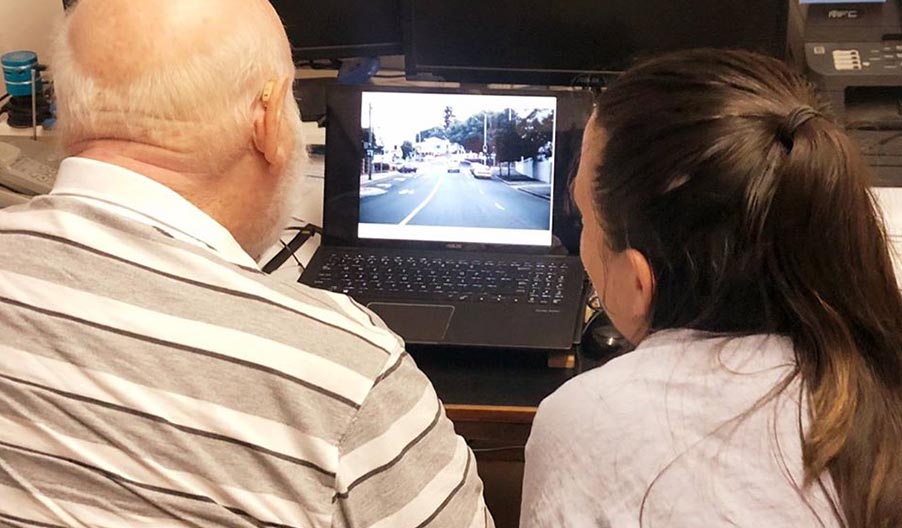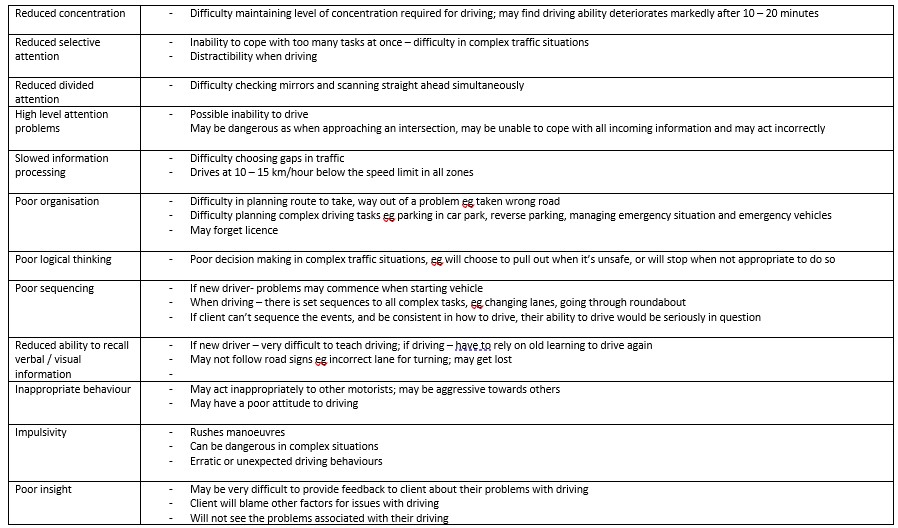For experienced drivers, it is easy to forget just how complex driving is….. what do you think driving involves? Steering the steering wheel? Using the pedals? Indicating? Keep going, you’ll think about scanning, procedures, taking safe gaps, following the road rules… however, driving is much more than turning the steering wheel and pressing the pedals! To be a driver, we need to be able to read the traffic environment and make decisions VERY quickly, react, and plan ahead.
Michon’s model of driving performance outlines three areas of skill required for driving:
- Operational skills: basic operation and decision in routine situations – eg operating the pedals and steering wheel for basic control of the vehicle – managing intersections, speed control, observing traffic environment.
- Tactical skills: complex decision making in non-routine situations – eg more complex intersections and decision making (eg busy multilane roundabouts/cross intersections), highspeed situations, managing complex carparks, roadworks zones, detours, traffic jams, adverse weather conditions, self-navigating in unfamiliar areas, wrong turns.
- Strategic skills: being able to plan driving ahead of time – eg need to be at work at 11, therefore have to start getting ready by 10 and leave by 10:30am; need to get fuel, need to check tyres/air pressure, need to check for flooded roads.
Michon’s model:
The Assessing Fitness to Drive Guidelines 2016 (the ‘bible’ used by medical and health professionals for driving and medical conditions) states:
Driving is a complex instrumental activity of daily living. It involves a complex and rapidly repeating cycle that requires a level of skill and the ability to interact with both the vehicle and the external environment at the same time. The demands of the driving task can vary considerably depending on a range of factors including those relating to the driver, the vehicle, the purpose of the driving task and the road environment. Information about the road environment is obtained via the visual and auditory senses. The information is operated on by many cognitive processes including short- and long-term memory and judgement, which leads to decisions being made about driving.
Decisions are put into effect via the musculoskeletal system, which acts on the steering, gears and brakes to alter the vehicle in relation to the road. This repeating sequence depends on:
- Sensory input: vision, visuospatial perception, hearing
- Cognitive function: attention and concentration, comprehension, memory, insight, judgement, decision making, reaction time, sensation
- Motor function: muscle power, coordination.
Given these requirements, it follows that many body systems need to be functional in order to ensure safe and timely execution of the skills required for driving. The driver’s sensory, motor and cognitive skills may require detailed assessment to determine the potential impact on driving.
In simple terms, cognition is our memory and thinking skills – it allows us to read and make sense of the environment, to make decisions, to react in a timey manner, to have awareness of errors and correct these, to learn. Without sufficient cognitive functioning, driving is impossible.
Occupational therapy driver assessors include a thorough screen of cognitive functioning in the clinical or “off-road” part of the driving assessment, and then this is reviewed practically during the on-road driving assessment.
Clients may have impairment of cognition due to various reasons – eg stroke, brain injury, other neurological conditions such as Parkinson’s disease and Huntington’s disease, Alzheimer’s/Dementia, or a mild cognitive impairment which may be associated with age-related changes. For many people, getting older can lead things generally slowing down – including slowed speed of information processing – that is, taking longer than it used to, to read the situation, react and make decisions. This often doesn’t impact on day-to-day tasks – it doesn’t really matter if it takes a little longer to do the grocery shopping, cook a meal or do a puzzle – but it is a HUGE problem when it comes to driving. To be a safe driver, we need to be consistent and reliable with being able constantly observe the traffic environment (and not miss any signs or hazards), react and make decisions accordingly.
The table below outlines different aspects of cognition, and how these may impact on driving.
What does this mean for driving?
There are three possible outcomes from any occupational therapy driving assessment:
(Definition: A critical error is where the driving instructor has to intervene on the steering wheel / brake / accelerator for safety – this is only done when absolutely needed, and the client is given a chance to recognise and react themselves, prior to the instructor intervening).
“Pass”: medical condition is not impacting on driving and therefore safe to continue driving.
In practice, this would mean:
- in the clinical / off-road assessment: there would be appropriate performance
- in the practical assessment: no critical driving errors, minimal non-critical driving errors, aware of errors, acknowledging feedback from driving instructor and OT, implementing feedback consistently.
“Driving program: trial of lessons”: client has not yet passed – requires lessons / refresher sessions with the specialised Driving Instructor to attempt to address concerns seen in the initial on-road assessment or learn to drive with vehicle modifications. In practice this would mean:
- in the clinical / off-road assessment: some concerns in the cognitive tests
- in the practical assessment: critical and non-critical driving errors, showing some awareness of errors, making an attempt to implement feedback, but inconsistent with this.
- recalling the feedback and errors after the assessment
- being open to learning and improving their driving
“Fail”: medical condition is impacting on driving and no longer safe, and recommendation that the licence will be cancelled and the person is recommended to retire from driving.
- In practice, this would mean:
- in the clinical / off-road assessment: poor performance in the cognitive tests
- in the practical assessment: critical and non-critical driving errors, not aware of errors or driving instructor intervention, not able to implement any feedback or make any improvements with driving
- not recalling feedback or errors after the assessment
- poor memory to be able to remember strategies to improve driving
- poor awareness/insight into medical condition and driving performance
Safety first....
Safety trumps everything…. most people can operate the car (steering and pedals), but if they are not reading the environment appropriately and not processing things quickly enough – this is not going to be safe, and this means that it is time to retire from driving.
#occupationaltherapydrivingassessment #cognition #olderdrivers #neurologicalconditions #retiringfromdriving
References:
Michon, J. A. (1985). A critical view of driver behavior models: What do we know, what should we do. In L. Evans & R. C. Schwing (Eds.), Human behavior and traffic safety (pp. 485–520). New York: Plenum Press.

